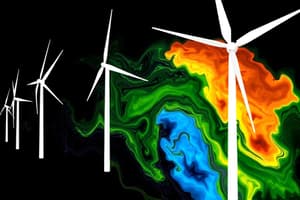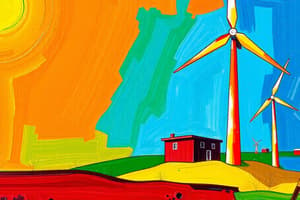Podcast
Questions and Answers
What role does the gear system and coupling play in a wind-electric conversion system?
What role does the gear system and coupling play in a wind-electric conversion system?
- It senses environmental conditions to optimize energy output.
- It converts electrical energy into mechanical energy.
- It controls the yaw of the wind turbine.
- It increases the rotational speed and transmits it to the generator rotor. (correct)
Which component is responsible for aligning the wind turbine blades with the wind direction?
Which component is responsible for aligning the wind turbine blades with the wind direction?
- Wind Turbine
- Yaw motor gear (correct)
- Controller
- Generator
What is a primary limitation of wind energy captured by wind-electric systems?
What is a primary limitation of wind energy captured by wind-electric systems?
- Wind energy systems are maintenance-free and reliable.
- Wind energy is consistently available throughout the year.
- Wind turbines require minimal land space for installation.
- Wind energy is inherently noisy and can disturb nearby areas. (correct)
What does the controller in a wind-electric conversion system primarily do?
What does the controller in a wind-electric conversion system primarily do?
Which of the following is NOT a challenge associated with wind energy systems?
Which of the following is NOT a challenge associated with wind energy systems?
Which factor does NOT control the output of a wind energy converter?
Which factor does NOT control the output of a wind energy converter?
What is a primary benefit of alternative energy resources?
What is a primary benefit of alternative energy resources?
Which of the following is NOT considered an alternative energy resource?
Which of the following is NOT considered an alternative energy resource?
Which of the following site features is LEAST favorable for wind power generation?
Which of the following site features is LEAST favorable for wind power generation?
What is the main reason that alternative energy resources are becoming increasingly important?
What is the main reason that alternative energy resources are becoming increasingly important?
Which aspect does NOT affect the air density necessary for wind energy conversion?
Which aspect does NOT affect the air density necessary for wind energy conversion?
Which is a major impact of using alternative energy on local economies?
Which is a major impact of using alternative energy on local economies?
Which factor is NOT considered when selecting a site for wind power generation?
Which factor is NOT considered when selecting a site for wind power generation?
Flashcards are hidden until you start studying
Study Notes
Wind-Electric Conversion System Components
- Wind turbine (WT) transforms wind energy into rotational mechanical energy.
- Gear system and coupling (G/C) increase speed and transmit it to the generator rotor.
- Generator (G) converts rotational energy into electrical energy.
- Controller (C) monitors wind conditions and generator output to initiate control actions.
- Yaw motor gear aligns turbine blades with wind for maximum energy capture through vertical rotation.
Limitations of Wind Energy
- Wind energy is dilute and fluctuates, making it inconsistent.
- Requires energy storage systems to address irregular supply.
- Noisy operations can disturb areas several kilometers away.
- High overall weight due to tall towers and complex components like gears and generators.
- Large land areas are necessary for wind farms.
- Current systems are not maintenance-free and face reliability issues.
Alternative Energy Resources
- Includes wind, solar, biomass, geothermal, water, and gas hydrate.
- Shift away from conventional sources like oil, natural gas, and coal is necessary as they contribute to approximately 80% of energy consumption.
Importance of Alternative Energy
- Fossil fuels are at risk of exhaustion in the near future.
- Conventional energy sources are not clean, with nuclear energy being the only exception (but with safety challenges).
- Growing energy consumption requires sustainable alternatives to meet demand.
- Zero greenhouse gas emissions promote a healthier environment.
- Diversification of energy supply reduces reliance on imported fuels.
- Economic development opportunities arise from installation and local projects.
- Helps rural communities reduce dependency on fossil fuels and improves human health with advancements like biogas plants.
Wind Energy Fundamentals
- Wind is generated by air motion due to pressure gradients from solar energy heating the Earth.
- Devices that slow moving air can convert wind energy into usable work.
- Key factors influencing wind energy output include wind speed, rotor cross-section, conversion efficiency, generator effectiveness, and transmission systems.
Principles of Energy Output
- Air density impacts wind power output; it is influenced by altitude, temperature, and barometric pressure.
- Variation in temperature and pressure can affect air density by up to 10%. Warmer climates typically reduce air density.
Site Selection Considerations for Wind Power Generation
- Ideal sites have high annual wind speeds with no tall obstructions within a 3 km radius.
- Preferred locations include open plains, smooth hilltops, or wind-funneling mountain gaps.
- Factors such as altitude, terrain aerodynamics, local ecology, and proximity to infrastructure (roads/railways) are important.
- Site selection should also consider ground characteristics and land costs for feasibility.
Studying That Suits You
Use AI to generate personalized quizzes and flashcards to suit your learning preferences.





